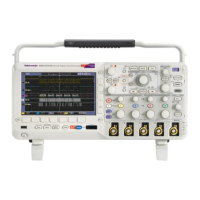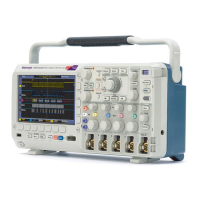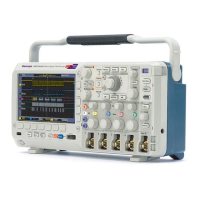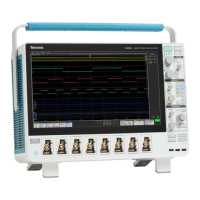
Do you have a question about the Tektronix MSO2012B and is the answer not in the manual?
| Brand | Tektronix |
|---|---|
| Model | MSO2012B |
| Category | Test Equipment |
| Language | English |
Safety precautions for avoiding fire and personal injury during operation.
Definitions of terms and symbols used throughout the manual for clarity and safety.
Details the EMC standards the instrument complies with, including EC Declarations.
Information on safety standards, including EC Low Voltage Directive and U.S. testing laboratory listings.
Guidelines for recycling and proper disposal of the instrument at the end of its life.
Highlights the main features and capabilities of the MSO2000B and DPO2000B series oscilloscopes.
Explains the icons and conventions used throughout the manual for better understanding.
Instructions for unpacking and checking standard accessories and recommended items before installation.
Details environmental and operational specifications like power, weight, dimensions, and operating conditions.
Explains how to connect different types of probes (TekVPI, TPA-BNC, Digital) to the oscilloscope.
Step-by-step guide on how to properly power on the oscilloscope, including grounding.
Procedure to compensate passive voltage probes for accurate measurements.
Instructions on how to download and install the latest firmware for the oscilloscope.
How to connect and communicate with the oscilloscope using VISA drivers for data acquisition and analysis.
How to access and control the oscilloscope remotely via a web browser.
Guide for setting up and acquiring signals using the digital channels specific to MSO2000B models.
Procedures for setting up analog channels to acquire signals using front-panel controls.
How to add custom labels to channels and buses for easy identification on the display.
How to use the FilterVu feature to filter noise and capture glitches for a cleaner signal display.
Explains trigger events, time reference, and different trigger modes (Normal, Auto).
Guide to selecting various trigger types like Edge, Pulse Width, Logic, and Bus.
Instructions for setting up triggers for various serial and parallel buses (CAN, I2C, SPI, etc.).
How to add or remove waveforms from the display using front-panel buttons.
Options for adjusting display style, persistence time, and auto settings for waveform viewing.
Using horizontal and vertical controls to adjust waveform display, scale, and position.
Configuring input parameters such as coupling, invert, bandwidth, and probe setup for channels.
Procedure to perform automatic measurements on waveforms using the Measure function.
Lists and describes various automatic time and amplitude measurements available.
Using on-screen cursors for manual measurements of time, amplitude, and other parameters.
Creating math waveforms by combining and transforming source waveforms for advanced analysis.
Performing Fast Fourier Transform (FFT) to analyze signal frequency components.
Utilizing Wave Inspector controls (zoom, pan, play/pause) for efficient analysis of long waveforms.
Locating and marking points of interest on waveforms automatically or manually.
Procedures for capturing and saving the oscilloscope's screen display as an image file.
How to save and recall waveform data points to internal memory or external storage.
Saving and recalling oscilloscope configurations, including acquisition, trigger, and measurement settings.
Using the TekSecure function to securely erase all stored data and settings from the oscilloscope.
Details the features of the DPO2EMBD module for serial bus analysis.
Details the features of the DPO2AUTO module for automotive serial bus analysis.
Details the features of the DPO2COMP module for computer serial bus analysis.











